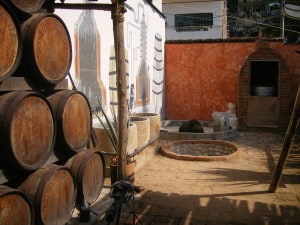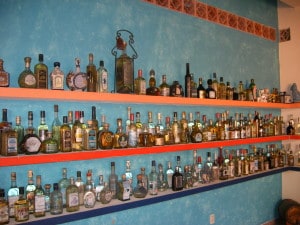As the docking procedure in Puerto Vallarta takes such a short time, we normally arrive at the pilot station 1 hour before our official brochure time. Thus we were there waiting for the pilot at 07.00 hrs the good thing was, he was also waiting for us and that kept any delay to a minimum. At 07.01 he hopped on board and by 07.10 we entered the port, spun around in the harbor and came portside alongside berth nbr 2. Today portside docking was required as our 3rd officer lifesaving wanted to test his tender platforms for tomorrow when we are in Cabo San Lucas. As that is a short stop, we need both forward platforms in operation to run with four ships tenders and 2 shore tenders, to make it as smooth a service as possible. How smooth that will be depends on the amount of swell running into the bay. You never can tell what that will be, as the swell can curve around the Cape and enter the bay, even when outside it is coming from a totally different direction. So we need both sides of the ship to be in operation to have a lee side available for in case there is a swell. Hence the need to dock portside to check the platform out.
The Sapphire Princess came in at 08.30 and was docked by 09.00 hrs so for the remainder of the day, the bridge officers had to look at an apartment building parked about 300 feet away from them. When somebody on one of the balconies then proceeded to hang out the laundry, it just felt as if we were ashore in a Big City Suburb. I hope that they took it all in before sailing, as a washing line on a balcony and a moving ship do not go very well together.
The basins and barrels for the ripening and aging of the tequila. (Courtesy both photos by roving reporter Lesley)
Roving report Lesley went on a tour today and ended up at a Tequila Distillery. I had always wondered how they made tequila, not the industrial version in large quantities, but the home grown version. What we would call today a micro brewery. As Tequila is the national liquor of Mexico it can be expected that there is an enormous number of small distillery’s out there, and the visitors were not disappointed.
Some bottles are little works of art in itself.
The owner explained the whole process, from plant until the finished product, but also showed his collection of various tequila bottles. There was a sort of hobby exchange between the various distillery’s and with a bottle for bottle swapping he had built quite a nice collection of shapes and sizes. Looking at the photo, there are a few that are real creations and worthwhile having just for the bottle alone, apart from the contents. Although it was an impressive collection, I think it was far from complete as Mexico is a very large country with an infrastructure that is far from perfect, so I assume that Pepe Gonzales still buys his tequila from the local brewery and not from a national chain. I wonder if there is a national tequila museum somewhere that would have a complete collection.
We were loading MGO (Marine Gas Oil) today to top up our tanks. For the stretch in and out of San Diego it is a Californian law requirement to run our engines on MGO and Puerto Vallarta is a good port to buy it as it is about $ 100,– cheaper than in the States. On 55 tons that saves us nearly $6000, — and if you do that 10 times in the year, the savings are considerable. At the same time we offloaded sludge, the left over residual that is filtered out of the oil by the purifiers. Mexico is getting quite advanced in the area of recycling and nearby Puerto Vallarta they have a processing plant where the stuff is recycled and becomes a component for tar that is used for road coverings. We pay for the offloading and combined with the sales price of the finished product, the recycling company can make a profit. To ensure that the recycling indeed takes place, Holland America only works with approved vendors, licensed by the government, and on occasion we send our Safety/Environmental/Health officer to have a look to see how it is done.
The last 5 cubic meters of fuel came on board at exactly 14.00 hrs and so we could pull off the dock without any delay. It is an 18 knot run to Cabo San Lucas, not counting the current and wind which both are expected to be against us, and so we put the pedal to the metal to ensure that we would arrive on time. The plan is to anchor at 06.30 so that the whole circus is in full operation by 07.00 hrs our official arrival time. The ship has been pre-cleared by the authorities as with three ships in port there are not enough officials to come on board all ships at the same time.



Leave a Reply